Products Category
- FM Transmitter
- 0-50w 50w-1000w 2kw-10kw 10kw+
- TV Transmitter
- 0-50w 50-1kw 2kw-10kw
- FM Antenna
- TV Antenna
- Antenna Accessory
- Cable Connector Power Splitter Dummy Load
- RF Transistor
- Power Supply
- Audio Equipments
- DTV Front End Equipment
- Link System
- STL system Microwave Link system
- FM Radio
- Power Meter
- Other Products
- Special for Coronavirus
Products Tags
Fmuser Sites
- es.fmuser.net
- it.fmuser.net
- fr.fmuser.net
- de.fmuser.net
- af.fmuser.net ->Afrikaans
- sq.fmuser.net ->Albanian
- ar.fmuser.net ->Arabic
- hy.fmuser.net ->Armenian
- az.fmuser.net ->Azerbaijani
- eu.fmuser.net ->Basque
- be.fmuser.net ->Belarusian
- bg.fmuser.net ->Bulgarian
- ca.fmuser.net ->Catalan
- zh-CN.fmuser.net ->Chinese (Simplified)
- zh-TW.fmuser.net ->Chinese (Traditional)
- hr.fmuser.net ->Croatian
- cs.fmuser.net ->Czech
- da.fmuser.net ->Danish
- nl.fmuser.net ->Dutch
- et.fmuser.net ->Estonian
- tl.fmuser.net ->Filipino
- fi.fmuser.net ->Finnish
- fr.fmuser.net ->French
- gl.fmuser.net ->Galician
- ka.fmuser.net ->Georgian
- de.fmuser.net ->German
- el.fmuser.net ->Greek
- ht.fmuser.net ->Haitian Creole
- iw.fmuser.net ->Hebrew
- hi.fmuser.net ->Hindi
- hu.fmuser.net ->Hungarian
- is.fmuser.net ->Icelandic
- id.fmuser.net ->Indonesian
- ga.fmuser.net ->Irish
- it.fmuser.net ->Italian
- ja.fmuser.net ->Japanese
- ko.fmuser.net ->Korean
- lv.fmuser.net ->Latvian
- lt.fmuser.net ->Lithuanian
- mk.fmuser.net ->Macedonian
- ms.fmuser.net ->Malay
- mt.fmuser.net ->Maltese
- no.fmuser.net ->Norwegian
- fa.fmuser.net ->Persian
- pl.fmuser.net ->Polish
- pt.fmuser.net ->Portuguese
- ro.fmuser.net ->Romanian
- ru.fmuser.net ->Russian
- sr.fmuser.net ->Serbian
- sk.fmuser.net ->Slovak
- sl.fmuser.net ->Slovenian
- es.fmuser.net ->Spanish
- sw.fmuser.net ->Swahili
- sv.fmuser.net ->Swedish
- th.fmuser.net ->Thai
- tr.fmuser.net ->Turkish
- uk.fmuser.net ->Ukrainian
- ur.fmuser.net ->Urdu
- vi.fmuser.net ->Vietnamese
- cy.fmuser.net ->Welsh
- yi.fmuser.net ->Yiddish
History of Radio - Who Invented the Radio?
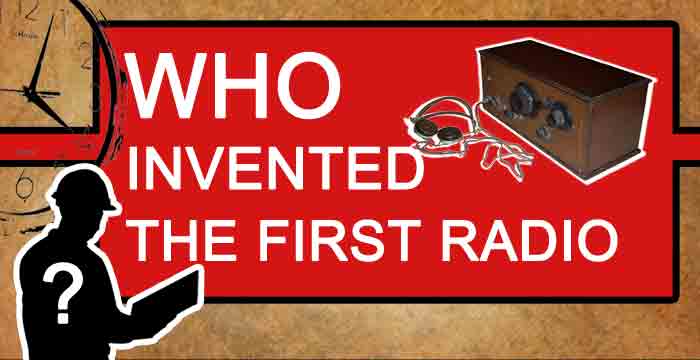
“Who invented the radio? Why is radio important? What is the history of radio? This article will give you a detailed introduction to the the history of radio and the development of radio. ----- FMUSER”
If you like it, share it!
Who Invented the Radio | What is Radio Technology?

Before we get started, do you know what radio means? Radio Refers To Wireless and Communication Technology Using Signaling and Communication, Which Use Radio Waves. Wireless can be understood as a method of transmitting electric energy from one place to another without using any type of linear connection. Because of radio "wireless" technology, radio technology is widely used in radio communication, radar, radio navigation, remote control, remote sensing, and other applications.
The radio may be one of our most common products, using radio means that the wave transmits energy, the role of the radio is to receive radio signals, and the device transmitting radio waves is referred to as a radio transmitter. The radio waves transmitted upward from the transmitter are transmitted from one side of the world to the other side by air, eventually received by a radio receiver (such as a radio, etc.).
In radio communication, radio technology is used for many other uses between radio broadcasting and television broadcasting, mobile phones, two-way radio, wireless networks, and satellite communications. By modulating radio signals, using radio waves through the transmitter cross space to the receiver Information (by changing the transmitter, the information signal is printed on radio waves by changing some aspects of the wave).
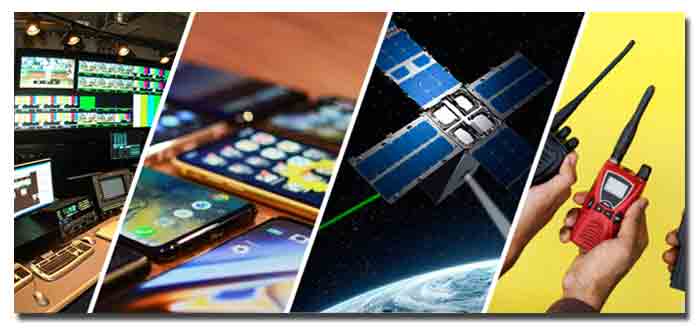
In the radio navigation system (e.g., GPS and VOR), the mobile receiver accepts the radio signal of the navigation radio signal from its position, and the receiver can calculate the position on the earth by accurately measuring the arrival time of the radio wave.
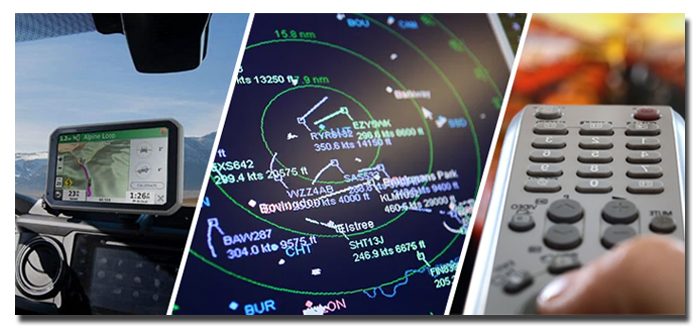
What Can I Get from this Post? (Click to visit!)
How Radio was Invented?
Who Invented the Radio?
What is The Importance of the Radio?
What is The History of the Radio?
What's the Radio History of Philippines?
How to Find the Reliable Radio Manufactuer?
People are also Curious About These Questions
Extra Reading for You:
1. What is VSWR and how to measure VSWR?
2. Know RF Better: The Advantages and disadvantages of AM, FM, and Radio Wave
3. What's the Difference between AM and FM?
4. How to DIY your FM Radio Antenna|Homemade FM Antenna Basics&Tutorials
5. How To Load/Add M3U/M3U8 IPTV Playlists Manually On Supported Devices
6. What is Printed Circuit Board (PCB) | All You Need to Know
Who Invented the Radio | The Birth of the Radio
The question as to who invented the radio does not have a specific answer. There have been numerous theories and patents filed for credits. In case of the discovery of the radio, one fine understanding is that many theories and principles went into a completed circuit of the radio. These were contributed by not one, but many researchers. The theory behind each discovery led to the practical experimentation of the same, but in most cases, by another researcher. We can say that the radio was more of a discovery formed by contributions by many researchers, and not an invention that gave credit to a single inventor.
The first name, however, that bags credit is Guglielmo Marconi. He was the first person to successfully apply the theories of wireless technology. In 1895, he sent out the first radio signal, which consisted of the single letter 'S'. With this, he was granted the world's first patent for the radio. However, with time, it was proved that many theories used in the making of a radio were actually first patented by Nikola Tesla. Therefore, in 1943, the government authorized the patent for the radio invention to Tesla.
But many discoveries have been documented in the history of radio, the patents of which are controversial (some even till date). Below is the timeline of events and research that have made the radio the greatest, yet the most controversial discovery.
Also read: 50 "Must-Have" Broadcast Equipment | Pro Radio Rack Room Equipment List
Who Invented the Radio | Important Scientists in Radio History
Historically, there is no scientist or special someone who "invented" the radio, but it is worth noticing that in the early development of radios, several major outstanding scientists have played an indelible role in the development of the radio, and they are:
Mahlon Loomis(1826-1886)
James Clerk Maxwell(1831-1879)
Guglielmo Marconi(1874-1937)
Nikola Tesla(1856-1943)
Heinrich Rudolf Hertz(1857-1894)
William Dubilier (1888 - 1969)
Reginald Fessenden (1866 - 1932)
Edwin Howard Armstrong(1890 - 1954)
Who is Mahlon Loomis? What Did Mahlon Loomis Do?
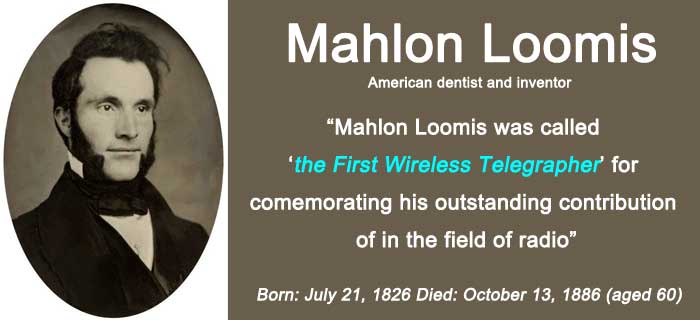
Guglielmo Marconi can be regarded as one of the first scientists to invent the radio, Guglielmo Marconi is also known as "the real father of the radio", but in fact, as early as 1866, eight years before Marconi was born, Mahlon Dr. Loomis carried out the earliest radio communication in the Blue Ridge Mountains on the outskirts of Lynchburg. Although Loomis did not obtain stable financial support for radio discovery and invention patent, his contribution to the field of the radio is still outstanding.
As we all know, the working mode of radio is not complicated: a transmitter moves electric charges up and down rhythmically on an antenna, which sets the signal to be set in motion. These electric charges make up radio waves, which are made of a repeating series of peaks and valleys. The waves sent then move in a straight line to a receiver/detector, like the antenna on your radio. Adjusting the strength (amplitude) of the wave gives us AM radio waves, and adjusting the frequency of the waves gives us FM radio waves. The shape of these waves tells the receiving radio’s speakers how to move to emit sound waves.
However, it was not easy for the beginning of radio at that time. Mahlon is interested in the charge that can be obtained by kites carrying wires in the upper atmosphere. At first, he planned to use this natural power source to replace the battery on the telegraph circuit. In many references, this is something actually implemented over a 400-mile telegraph line.
In 1868, Mahlon Loomis showed off the wireless "communication" system of a group of congressmen and distinguished scientists, 14 to 18 miles in two locations. From a mountain peak, he sent out a kite, the bottom of which was covered with thin copper gauze, and the string of the kite was copper wire. He connected the device to the current meter and the other end of the circuit to the ground. The current meter shows the passing of the current immediately!
Then he set up the same gear on a mountain 18 miles away, sending. He will touch the second kite wire to the ground, and through this action, the voltage of the charged layer is reduced, and the deflection of the flowmeter attached to the other kite is reduced at the first position.
This enabled him to develop it as a wireless telegraph system for practical long-distance communication.
Later, speaking in Congress, Mahlon Loomis mentioned that "causing electrical vibrations or waves to pass around the world, as upon the surface of some quiet lake one wave circle follows another from the point of the territory to the remote stores so that from any other mountain top up on the globe another conductor, which shall pierce this plane and receive the impressed vibration, may be connected to an indicator which will mark the length and duration of the vibration; and indicate by any agreed system of notation, convertible into human language, the message of the operator at the point of the first disturbance."
However, Mahlon Loomis's action did not attract the world's attention as the experiments and successes conducted by Guglielmo Marconi, because the wireless system was not complete at that time. It was not until the scientists of Guglielmo Marconi's generation that their functions and practicability were gradually realized.
Why is Mahlon Loomis "the first wireless telegraph"? Mahlon Loomis's position in the history of radio communication can be fully proved by the following seven points:
1. He is the first one to use the complete antenna and ground system
2. He is the first one to carry out the experimental transmission of wireless telegraph signals.
3. For the first time, the kite was used to carry the antenna at high altitudes.
4. He is the first one to use a balloon to lift the antenna wire
5. He is the first one to use the vertical antenna (the steel pole is installed on the top of the wooden tower).
6. He is the first one to put forward the idea of "wave" propagating from his antenna.
7. He is the first one to apply for the radiotelegraph patent.
Mahlon Loomis succeeded in getting his two kites and their electrical apparatus to talk with each other in this way within a few miles, which marked a great leap in the development of the radio. Therefore, to commemorate the outstanding contribution of Loomis in the field of radio, Mahlon Loomis was affectionately called "the First Wireless Telegrapher."
Mahlon Loomis is a scientist with an ambitious spirit of invention and entrepreneurship. He was born in Fulton County, New York on July 20, 1826, and moved with his family to Springfield, Virginia, about 20 miles south of Washington around 1840 and died in October 13, 1886 in Terra Alta, WV.
Back to the Content | Back to the Top
Who is James Clerk Maxwell? What Did James Clerk Maxwell Do?
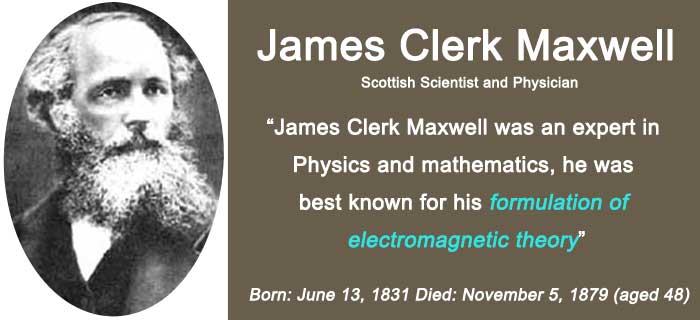
James Clerk Maxwell, one of the world's greatest Scottish scientists in electromagnetism, astronomy, the motion of gases, optics, is well-known for proving the link between electricity, magnetism, and light for the first time. He also determined what the rings of Saturn are made of and devised a theory relating to gases. James Clerk Maxwell had also produced the first color photograph. Maybe we do not know James Clerk Maxwell much, but thanks to his theories, which is essential in the development of modern communication technology.
James Clerk Maxwell is often called one of the world's greatest physicists. He was also a major influence on other important scientists, like Albert Einstein.
Maxwell's theories were essential in the development of technology we now take for granted, for example, radio broadcasting, the television broadcasting and mobile devices such as mobile phones.
Maxwell is best known for his research in electromagnetic radiation, he saw analogies between the speeds of travel of electromagnetic waves and of light and devised four important mathematical equations which formulated these and other relationships between electricity and magnetism.
Maxwell died of stomach cancer at the age of 48 and buried in Parton churchyard, near Glenlair in Dumfries and Galloway.
Back to the Content | Back to the Top
Who is Guglielmo Marconi? What Did Guglielmo Marconi Do?
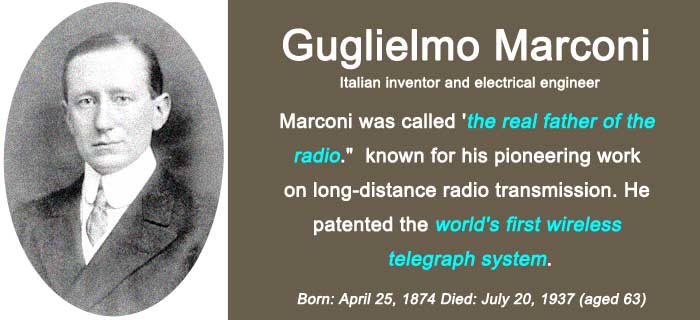
In the same year, he demonstrated to the Italian government in Spezia, where the wireless signal reached 12 miles. In 1899, Guglielmo Marconi established wireless communication between France and Britain through the English Channel. He set up a permanent wireless station in the needles on the Isle of Wight. In 1900, Guglielmo Marconi obtained the famous patent No. 7777 for "tuned or resonant Telegraph".
On a historic day in December 1901, he decided to prove that radio waves were not affected by the curvature of the earth, so he used his system to transmit the first radio signal across the Atlantic between Poldhu, Cornwall, and St. John's in Newfoundland, at a distance of 2100 miles. In 1931, Marconi began to study the propagation characteristics of a shorter wave, and in 1932, he established the world's first microwave wireless telephone link between Vatican City and the Palace of Castel Gandolfo.
Back to the Content | Back to the Top
Who is Nikola Tesla? What Did Nichola Tesla Do?
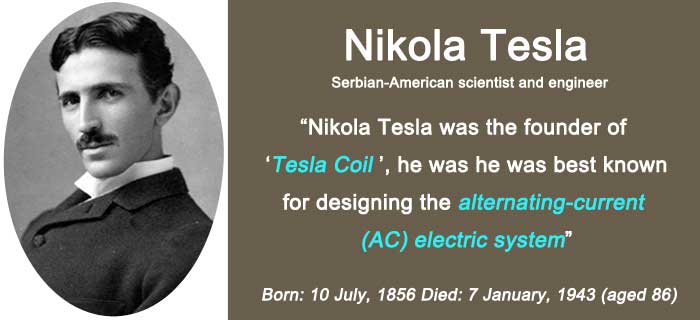
Nikola Tesla (1856-1943) is a famous engineer and physicist from the United States. He was born in Smiljan, Croatia. His father was a pastor of the Orthodox Church in Serbia, his mother ran the family's farm, and Tesla studied mathematics and physics at Graz Technical University and philosophy at Prague University.
Nikola Tesla is a famous genius inventor, especially in the field of power production, power transmission, and power applications. The Tesla coil we know well is invented by Nikolay · Tesla. Besides, Nikola · Tesla is also the inventor of the first AC motor and the developer of AC power generation and transmission technology and has made admirable achievements in many fields.
Back to the Content | Back to the Top
Who is Heinrich Rudolf Hertz? What Did Heinrich Rudolf Hertz Do?
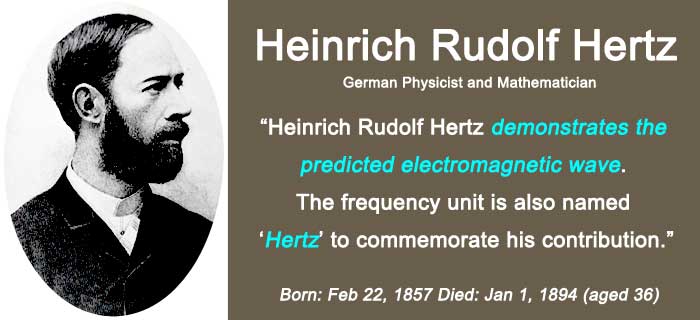
Heinrich Rudolf Hertz was called "the father of frequency", he was born in Hamburg, German on February 22, 1857. He is also a world-famous German physicist who discovered radio waves. The theories of Heinrich Rudolf Hertz which had paved the way for uncountable advances in radio communication technology were widely seen as a milestone of the demonstration of James Clerk Maxwell's predicted electromagnetic theory. Hertz's theories were closely related to some broadcast equipment and broadcast technologies such as the radio, radar, wireless telegraphy, television, the dipole antenna, and radio transmitter.
The common unit of frequency, known as Hertz (Hz-cycles per second), which became included in the metric system in 1933, was officially named by Heinrich Rudolf Hertz's name
Today the unit hertz is used in everything from radio broadcasting to measuring the frequency of light reflected by printer inks to measuring the speed of computer processing chips and much much more.
Heinrich Rudolf Hertz died in 1894 in Bonn, Germany.
Back to the Content | Back to the Top
Who is William Dubilier? What Did William Dubilier Do?
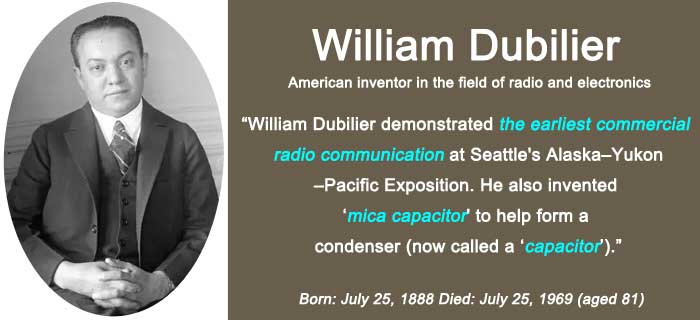
William Dubilier (1888 - 1969) was the founder of Cornell-Dubilier Electric Corp (CDE), he pioneered the development of self-healing, metalized dielectrics for capacitors, high-voltage transmitting capacitors, and antenna-shortening capacitors. Dubilier was also an American radio pioneer as well as an inventor who is famous for the invention of the radio.
If you have been in the electronics field for a while, you no doubt have heard of their capacitors. In fact, William Dubilier was the inventor of mica-based capacitors. Actually, William Dubilier was the first to use sheets of naturally occurring mica as the dielectric in a capacitor. The Mica capacitors revolutionized wireless communications, they were widely used in early radio oscillator and tuning circuits because the temperature coefficient of expansion of mica was low, resulting in very stable capacitance.
The transmitter required more than 50 Leyden jars for circuit capacitance. Dubilier's mica capacitor was sturdier, more efficient, smaller, and lighter than the Leyden jar. It made smaller electronic equipment possible. Mica capacitors are still used where exceptional temperature stability is needed.
William Dubilier died in West Palm Beach, Florida, on July 25, 1969, at the age of 81, he was granted more than 355 patents.
Back to the Content | Back to the Top
Who is Reginald Fessenden? What Did Reginald Fessenden Do?
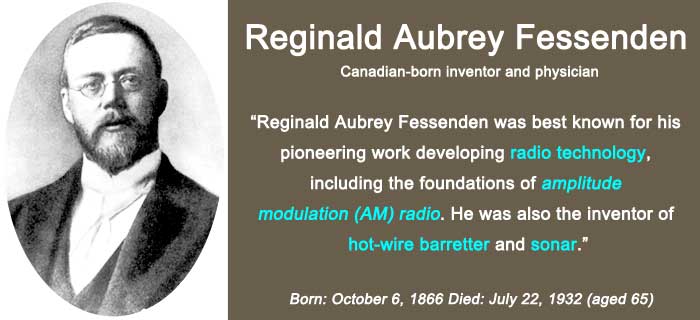
Fessenden was a famous Canada inventor and physician who is best known for his pioneering work developing radio technology, including the foundations of amplitude modulation (AM) radio. His achievements included the first transmission of speech by radio (1900), and the first two-way radiotelegraphic communication across the Atlantic Ocean (1906).
In the late 1800s, people communicated by radio through Morse code, with radio operators decoding the communication form into messages. Fessenden put an end to this laborious manner of radio communication in 1900 when he transmitted the first voice message in history.
Reginald Fessenden was an employee of Thomas Edison. Before he left Edison, though, Fessenden managed to patent several inventions of his own, including patents for telephony and telegraphy. Specifically, according to the National Capital Commission of Canada, “he invented the modulation of radio waves, the ‘heterodyne principle,’ which allowed the reception and transmission on the same aerial without interference.“
Six years afterward, the Canadian radio pioneer who on Christmas Eve in 1906 broadcast the first program of music and voice ever transmitted over long distances, ships off the Atlantic coast used his equipment to broadcast the first trans-Atlantic voice and music transmission. For Fessenden, 1906 was a triumphant year in which he achieved the world’s first two-way transatlantic radio transmission from Brant Rock. By the 1920s, ships of all kinds relied upon Fessenden's "depth sounding" technology.
Reginald Aubrey Fessenden (1866 - 1932) was born in Milton, Canada East [now Quebec] and died in Bermuda on July 22nd, 1932
Back to the Content | Back to the Top
What Makes Radio Communicatin Become Important?

1. Before the 1920s
Before and during the First World War, radio was mainly used to contact ships at sea. Radio communication is not very clear, so operators usually rely on Morse code messages. It's very good for ships in the water, especially in an emergency. With the first World War, the importance of radio became obvious, and its practicability was greatly improved. During the war, the military used it almost exclusively, and it became a valuable tool for sending and receiving messages to the armed forces in real-time without the need for physical messengers.
2. During the 1920s
After the war, in the 1920s, civilians began to buy radios for private use. In the United States and Europe, radio stations such as KDKA in Pittsburgh, Pennsylvania, and BBC in the United Kingdom are beginning to surface. In 1920, Westinghouse company applied for and obtained a commercial radio license, which allowed the creation of KDKA. KDKA will then become the first radio station officially authorized by the government. It was also the first time that Westinghouse started advertising the sale of radios to the public. Although artificial radio is gradually becoming the mainstream, for some families, the home radio receiver is a solution. This is starting to create problems for manufacturers who are starting to sell preforms. As a result, the government approved the radio corporation agreement (RCA).
In Britain, broadcasting began in 1922 at the BBC in London. Broadcasting spread rapidly in Britain, but it was not until the newspaper strike in 1926 that it usurped the newspaper. At this point, radio stations and the BBC have become the main sources of information for the public. In the United States and the United Kingdom, it has also become a source of entertainment. In families, gathering before broadcasting has become a common phenomenon in many families.
3. World War II and post-war changes
During the Second World War, radio stations once again played an important role in the United States and Britain. With the help of reporters, radio stations relayed the news of the war to the public. It was also a source of rallies and was used by the government to gain public support for the war. In the UK, it became the main source of information after the closure of television. After the Second World War, the use of radio also changed the world. Radio used to be the source of entertainment in the form of serial programs, but after the war, radio began to focus more on playing the music of the time. The "Top 40" of music became very popular during this period, and the target audience ranged from families, teenagers to adults in their thirties. Music and radio continued to be popular until they became synonymous with each other. FM radio began to replace the original AM radio, rock and roll and other new forms of music came into being.
The status quo and future of radio today, the development of radio has gone beyond the imagination of Tesla or Marconi. Traditional broadcasting and broadcasting have become the past. Instead, with the popularity of satellite and streaming Internet sites, radio stations have been steadily developing to keep up with current technological developments. Radios are found not only in homes but also in vehicles. In addition to music, radio talk shows have become a popular choice for many people. In two-way radio, the newer digital two-way radio allows one-to-one communication, which is usually encrypted to improve security. Short-range radio improves communication in the workplace. Handheld radio has become an indispensable part of sports, TV production, and even commercial aviation operation.
The roots of the radio trace back to the early 1800s. Hans Ørsted, a Danish physicist, laid the foundation of relativity between magnetic energy and direct current, in 1819. This theory later formed the basics for other progressive inventions of physicist André-Marie Ampère, who experimented with the formulations and invented solenoid.
⇓
This invention led other scientists and researchers to explore this theory further for practical use. In 1831, Michael Faraday from England developed the theory which stated that change in the magnetic field in an electric circuit could generate current or electromotive force in another wire or circuit. This theory was known as inductance. In the same year, Joseph Henry, a professor at Princeton, was simultaneously working on a similar theory of electromagnetic relay. Both of them were credited with the patents respectively. Henry bagged the patent for self-inductance and Faraday for mutual inductance.
⇓
The onset of the 1860s saw yet another scientific breakthrough. James Clerk Maxwell, a Scottish physicist and a professor at King's College, London, extended the theory that Joseph Henry and Michael Faraday introduced. He contributed greatly to the research on electromagnetism between 1861 to 1865. He predicted the existence of magnetic waves, and that the speed of their travel is constant.
⇓
Mahlon Loomis is called the 'First Wireless Telegrapher'. In 1868, he demonstrated a wireless communication system between two sites that were 14 to 18 miles apart. Amos Dolbear was a professor at Tufts University, and received a U.S. patent for a wireless telegraph in March, 1882.
⇓
In 1886, another great discovery stunned the scientific world. Heinrich Hertz, who was a German physicist and mechanician, discovered electromagnetic waves of energy which were much longer even if they traveled at the speed of light. In 1888, he became the first person to prove the presence of electromagnetic waves by constructing a system to create and detect UHF radio waves. He is credited to designing the first receiver and transmitter for the radio. His name is used as the standard unit for radio frequencies, which is 'Hertz'. The Hertz designation was an official part of the international metric system in 1933.
⇓
In 1892, Nathan Stubblefield first demonstrated wireless telephony. He was the first to use wireless telephone to broadcast human voice. It is believed that Stubblefield invented the radio before Tesla or Marconi. However, his devices appear to have worked by audio frequency induction or audio frequency earth conduction, rather than radio frequency radiation for radio transmission telecommunication.
⇓
Sir Oliver Lodge was experimenting with wireless transmission. In 1894, he designed a device called a 'coherer' up to perfection. This was a radio wave detector, and the basis of the early radiotelegraph receiver. He was showered with international recognition, as he became the first human to transmit a radio signal.
⇓
Alexander Popov constructed his first radio receiver containing a 'coherer' in 1894. He then invented the lightning-recording antenna in 1895. This was then modified as a lightning detector and demonstrated before the Russian Physical and Chemical Society, on May 7, 1895. This day is remembered by the Russian Federation as 'Radio Day'. It was in March 1896, that transmission of radio waves was done across disparate campus buildings in St. Petersburg. A radio station was built on Hogland Island to facilitate two-way communication by wireless telegraphy between the Russian naval base and the crew of the battleship General-Admiral Apraksin. This was done as per Popov's guidance in 1900.
⇓
It is during this time that a controversy was in the making. In England, in 1895, Guglielmo Marconi was also working on wireless communication. He got success with demonstrating wireless communication of radio. His first radio signal was sent and received in 1895. In 1896, he patented this discovery, and researched further for practical and commercial use of the radio. In 1899, a 26 mile link was laid between two cruisers containing Ducretet-Popov devices in France. In the same year, the first wireless signal was sent across the English Channel. In 1902, the letter 'S' was telegraphed from England to Newfoundland. This was the first triumphant transatlantic radiotelegraph.
⇓
Nikola Tesla did file for the first patent of inventing the radio in 1897, which was granted to him in the United States in 1900. Marconi too filed for a patent in USA in the same year (1900), as the first inventor of the radio. However, it was turned down, as it used many of Tesla's already patented inventions contributing to the radio.
⇓
In 1903, Valdemar Poulsen began arc transmission to create high-frequency alternators to send radio waves. The New York Times and the London Times knew about the Russo-Japanese war due to radio in 1903. In the next year, a commercial maritime radio network was established under the control of the Ministry of Posts and Telegraphs in France.
⇓
In 1904, the next three applications by Marconi for patents were turned down by the U.S. government. However, it is believed that Marconi had strong financial support. His radio company was flourishing and this backing helped him. The patent for radio invention was reconsidered and credited to Marconi in 1904. With this, he bagged the universal credit for the inventor of the radio.
⇓
In 1894, Sir J.C. Bose first demonstrated radio transmission in Calcutta, India, before the British Governor General. However, he did not patent his work. A few years later, in 1899, he demonstrated the same transmission of 'mercury coherer with telephone detector', in the Royal Society of London. He solved a major issue in radio development, which was the Hertz system being unable to penetrate walls or any other physical obstruction. It is believed that the coherer used by Marconi worked on the coherer design invented by Bose. No patents were filed by Bose, until 1901, when he applied for a patent for the invention of the radio. It was granted to him by the US government in 1904. However, by then, the invention of the radio had already been credited to Marconi, with worldwide recognition. ⇓
Reginald Fessenden was a Canadian inventor reputed for his achievements in early radio. The first audio transmission by radio in 1900, the first two-way transatlantic radio transmission in 1906, and the first radio broadcast of entertainment and music in 1906, were his three significant milestones. Fessenden concluded that he could devise a better system than the spark-gap transmitter and coherer-receiver combination that had been put forth by Lodge and Marconi. In 1906, he designed a high-frequency alternator and transmitted human voice over the radio.
⇓
From here on, development of the radio for more practical use began. In 1907, Lee Dee Forest invented the vacuum tube amplifier, which was known as the 'Audion', and enabled the amplification of signals, and also the Oscillion'. Human voice could be now transmitted instead of codes.
⇓
In 1910, a broadcast from the Metropolitan Opera House in New York city could be heard on a ship that was 12.5 miles away.
⇓
1911 to 1930 was the period of the growth of the radio. The Radio Corporation of America was founded. This was done by combining General Electric, Western Electric, AT&T, and Westinghouse. It was in this era that radio broadcasting began in Australia. Battery-powered receivers having headphones and valves were seen in France. A radio telephone concert was broadcast across the Atlantic Ocean to several receivers. In this era, radio broadcasting started in Shanghai and Cuba. The first regular broadcasts took place in Belgium, Norway, Germany, Finland, and Switzerland.
⇓
Edwin Howard Armstrong was also known as the inventor of the Frequency Modulation, i.e. FM. In 1933, he discovered that a constant signal could be easily picked, rather than a fluctuating frequency. So any transmission on the radio could be fine-tuned easily, even for an average person.
⇓
Controversy did not end here. In 1943, just a few months after Nikola Telsa's death, the U.S. Supreme court reconsidered Tesla's patent for invention of the radio. It concluded that most of Marconi's work for wireless transmission was already patented by Nikola Tesla. Hence, once again, the patent for the radio invention was deemed to be owned by Nikola Tesla.
Soon, radio became prevalent throughout the globe. What can be concluded from this is that, the invention of the radio has more than one inventor. Technology was being explored, and the stunning contributions by the many researchers mentioned above have made the invention of the radio possible.
The History of Radio broadcasting in Philippines
1. The First Radio Station in the Philippines
There is a debate on what exactly was the first radio station in the country. In 1924 an American established the first AM radio station KZKZ.
But an archive of radio broadcast histories revealed that in 1922, an American woman named Mrs. Redgrave made a test broadcast using a five-watt transmitter.
While little is known about Redgrave’s experiment, it is believed that the test broadcast made from Nichols field (now Villamor Airbase) could be the very first radio station in the Pearl of the Orient.
2. First Radio Network
Henry Hermann, founder of the Electrical Supply Company (Manila) gained permission, possibly from local government and the military to operate more than one station. The test broadcasts delivered music over the air to wealthy residents who owned radio receivers.
This network of test broadcasts, however, was summed up into one 100-watt powered AM station bearing the call letters KZKZ on 729 kHz.
Radio Corporation of the Philippines (RCP) later bought KZKZ in October 1924.
RCP expanded in Cebu putting up KZRC (Radio Cebu) in 1929, which is now DYRC.
3. Branded Radio Programs
All radio programs back in the day were English. They resemble pretty much like those radio shows heard from the continental US. In fact, the sponsorships were also patterned after famous American radio programs like the Listerine Amateur Hour or the Klim Musical Quiz.
4. Before KBP
Radio stations back then were not regulated until the year 1931. The Radio Control Board was instigated under the US colonial government. The regulating agency took care of the license applications and frequency allocation.
KBP came only in April 7, 1973.
5. Call Letters from K to D
KZ was used because the Philippines was then a colony of America. All call letters of radio stations in the US starter either with K or W.
Francisco Koko Trinidad, known as the father of Philippine Broadcasting attended the International Telecommunications Union (ITU) in 1947, held in Atlantic City in the US.
Trinidad proposed to use RP instead of KZ. But this was denied by the ITU and gave the letter D as a replacement to KZ.
“D” Was Originally for German Stations
Professor Elizabeth Enriquez of UP Manila, on her research, explained why Philippine radio station call letters start with “D” and why it actually meant Deutscheland, or the German name of Germany.
6. Timline of Radio History in Philippines
This is a timeline of History of Radio broadcasting in Philippines:
1930s to 1940s
KZRM, was a AM station in May 3, 1933 KZRH, was a AM station owned by H.E. Heacock Company also known as Radio Heacock
1940s to 1950s
in June 1, 1946 H.E. Heacock's Company was a relaunch as Manila Broadcasting Company call letter from KZRH to DZRH and DZMB
DZPI, its a began on March 20, 1949 by Philippine Broadcasting Corporation it was an AM station in the 1940's
in June 4, 1948 - 680 KZAS is an AM Radio Station of Far East Broadcasting Company (FEBC Philippines) was inaugurated in Karuhatan, Valenzuela. Later on 680 KZAS was changed to 702 DZAS as it continues till today.
1950s to 1960s
"DZBC" since 1950 owned by Bolinao Electronics Corporation on 1000 khz
DZAQ, since October 19, 1953 owned by Alto Broadcasting System on 620khz
DZBB, began broadcast on March 1, 1950 owned by Republic Broadcasting System on 580Khz
DZQL, began broadcast in 1956 owned by Chronicle Broadcasting Network on 830 Khz
DZYL, began broadcast in 1956 also from Chronicle Broadcasting Network First FM Radio at 102 Mhz
DZXL, began broadcast in 1956 also from Chronicle Broadcasting Network on 960 khz
DZFE, began broadcast in 1950 owned by Far East Broadcasting Company on 1030 KHz later on 98.7 Mhz
1960's
DZEC AM Station owned by Eagle Broadcasting Corporation in 1968 on 1050 khz
DZEM AM Station owned by Christian Broadcasting Service
DZUP and DZLB operated by University of the Philippines
DZST am operated by University of Santo Tomas
DZTC am operated by National Teachers College
All School operated station were shut down during martial rule.
The Radio became AM and FM frequencies.
DZFM and DZRM of The Philippine Broadcasting Service of the Philippine Government Managed by Francisco Trinidad on 710 and 1190 kHz respectively
DZTR established in 1965 owned by Trans-Radio Broadcasting Corporation on 980khz
DZBM of Mareco Broadcasting Network in 1963 on 740 khz
DZLM of Mareco Broadcasting Network in 1963 on 1430 khz
DZTM Manila Times Tagalog station owned by Chino Roces of Associated Broadcasting Company on 1380 khz
DZMT Manila Times Station owned by ABC on 1100 khz
DZWS Manila Times Womens Station Operated by ABC on 1070 khz
DZRJ of Rajah Broadcasting Network Established in 1963 AM on 780 khz
DZBU Manila Bulletin Radio Operated by Manila Daily Bulletin on 1460 khz
DZHP of Radio Mindanao Network on 1130 khz
1970s to early 1980s
DWIZ of Philippine Broadcasting Corporation on September 24, 1972 on 800khz
DWBL of FBS Radio Network on February 1, 1972 on 1190
DWFM of Nation Broadcasting Corporation on frequency 92.3 Mhz in July 2, 1973
DZMB of Manila Broadcasting Company was a moved from AM to FM Band frequency from 760 khz to 90.7 Mhz on February 14, 1975
DZTR was a launching as DWRT-FM frequency of 99.5 Mhz on September 3, 1976
DWLL of FBS Radio Network frequency 94.7 Mhz in 1973
DWLM of Mareco Broadcasting Network on frequency 105.1 Mhz in 1972
DWKB was a launching as DZMZ owned by Intercontinental Broadcasting Corporation on 89.1 Mhz
DWEI of Liberty Broadcasting Corporation on September 14, 1973 on 93.1 Mhz
DWWA of Banahaw Broadcasting Corporation on November 4, 1973 on 101.9 Mhz
DWAD of Crusaders Broadcasting System frequency 1080 kHz in 1972
1980s to 1990
DWTM of Sarao Broadcasting Systems on February 14, 1986 on 89.9 Mhz
DWCT-FM of Raven Broadcasting Corporation on May 27, 1988 Citylife 88.3 was a rename as Jam 88.3 callsign from DWCT to DWJM
DWKS of Makati Broadcasting Network in 1985 on 101.1 Mhz
DWRX of Audiovisual Communicators, Inc. On frequency 93.1 Mhz in August 23, 1983
DWBM-FM of Mareco Broadcasting Network in 1985 on 105.1 Mhz
DZMM on ABS-CBN Broadcasting Corporation on July 22, 1986 on 630 kHz
DWKO on ABS-CBN Broadcasting Corporation on October 1986 on 101.9 Mhz
DZAM on Nation Broadcasting Corporation on June 2, 1987 callsign from DZAM to DZAR on 1026 Mhz
1990s to 2000
DWET-FM on Associated Broadcasting Company on frequency 106.7 Mhz in February 21, 1992
DWCD-FM on Crusaders Broadcasting System on 1992 on 97.9 Mhz
We're the Expert for Building Your Radio Station

For any radio station, the radio transmitter, transmitting antenna, and other professional broadcasting equipments determine the program quality of the radio station. The excellent broadcasting room equipment can provide your radio station with excellent sound quality input and output so that your broadcast and your program audience are really connected together. For FMUSER, ensuring a better experience for the radio audience is also one of our missions. We have the most complete turnkey radio station solution and decades of experience in radio equipment production and manufacturing. We can provide you with professional advice and online technical support to build a personalized and high-quality radio station. CONTACT US and let us help you build your radio station dream!
People are also Curious About These Questions:
1. Who invented AM and FM?
Reginald Fessenden is the inventor of AM (Amplitude Modulation) while Edwin Howard Armstrong is the inventor of FM (Frequency Modulation).
2. Who invented the radio?
Guglielmo Marconi is considered as the real father of radio, he was the first person to successfully apply the theories of wireless technology. And Edwin Howard Armstrong is considered by many as the inventor of FM (Frequency Modulation) as well as the father of modern Radio
3. Who is the inventor of Radio?
There will not be specific names of the inventors of the radio, but the wireless communication technology contributed by the following scientists are still being beneficial:
Mahlon Loomis(1826-1886)
James Clerk Maxwell(1831-1879)
Nikola Tesla(1856-1943)
Heinrich Rudolf Hertz(1857-1894)
Guglielmo Marconi(1874-1937)
Reginald Fessenden (1866 - 1932)
William Dubilier (1888 - 1969)
Edwin Howard Armstrong(1890 - 1954)
4. Who is the inventor of frequency modulation (FM)?
Edwin Howard Armstrong developed wide-band frequency modulation, FM radio, which delivered clearer sound, free of static. He was one of the greatest electrical engineers in the early 1900s. While in college, he invented the regenerative circuit, which was the first amplifying receiver and the first reliable continuous-wave transmitter.
In 1918, he invented the superheterodyne circuit, a highly selective means of receiving, converting, and greatly amplifying very weak, high-frequency electromagnetic waves. His crowning achievement (1933) was the invention of wide-band frequency modulation, now known as the FM radio.
The inventions of electrical engineer Edwin Howard Armstrong were so important to wireless communication including radio or television. It is important that almost every wireless set makes use of one or more of its developments. That's why Edwin Howard Armstrong is called "the inventor of FM (Frequency Modulation)" as well as "the father of the modern radio."
Edwin Howard Armstrong was born on December 18, 1890, in Chelsea district, New York, NY., and died on February 1, 1954, in Manhatten, New York, NY.
5. What is DBI?
dBi refers to dB (isotropic.) dBi is the forward gain of an antenna, nmeasured in decibels (dBi), The dBi value reflects the antenna's directional / beamwidth characteristics, i.e. directional as opposed to omnidirectional. Generally, the hIgher the gain (dBi), the narrower the beamwidth, the more directional the antenna.
6. What is DBM?
dBm refers to dB(mW). dBm is is an expression of power in decibels per milliwatt. We use dBm when we are measuring power emitted from amplifiers. We measure that power in milliwatts which is typically abbreviated as mW.
7. How to measure DBI from antenna?
Step 1: Validated Intervention Program.
Step 2: Progress Monitoring.
Step 3: Diagnostic Data.
Step 4: Intervention Adaptation.
Step 5: Ongoing Progress Monitoring.
8. What is Antenna gain?
In electromagnetics, the antenna gain refers to the key performance number which combines the antenna's directivity and electrical efficiency. Literally, the antenna gain describes how much power is transmitted in the direction of peak radiation to that of an isotropic source. The antenna gain also indicates how strong a signal an antenna can send or receive in a specified direction.
9. What is a video encoder?
A Video Encoder refers to the hardware or software encoding device that can convert or encode corresponding digital video signals for a decoder. The rack-mounted video encoders are usually software encoders, these video encoders are more expensive than the hardware encoders, and not stable as well. FMUSER manufactures low-cost high-performance IPTV hardware encoders for live streaming, we can also customize IPTV turnkey solutions for your needs, contact us for more information!
If you like it, share it!

